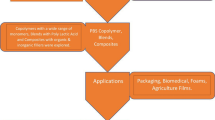Abstract
In view of the fast consumption of the petroleum stock and pressing demand for the use of polymeric materials to keep pace with the rate of growth of the world’s population the syntheses of polymers from agricultural products have achieved tremendous momentum at present all over the world. A number of Interpenetrating Polymer Networks were synthesized from polyol modified castor oil polyurethanes and cardanol based dyes. The structural characterization of the such polymers was performed using Fourier transform infrared spectral data. The thermal analysis methods such as Thermogravimetric Analysis, Derivative Thermogravimetry and Differential Thermal Analysis were used to determine their decomposition temperature, temperature of maximum decomposition, relative thermal stability and kinetic constants such as activation energy and order of reaction were calculated using the Freeman-Anderson method. X-ray diffraction analysis and Scanning Electron Microscopy were used to probe the morphological changes of the polymers with changes in their compositions. The effects of changes in polyurethane to dye monomer weight ratio on the properties of the polymers were studied at 1.2 and 1.6 NCO/OH ratios. These polymers exhibited very high thermal stability and mechanical strength and are expected to show excellent performance in various applications better than those shown by the co-polymers derived from simple cardanol (cashew phenol).
















Similar content being viewed by others
References
Sperling LH (1981) Interpenetrting polymer networks and related materials. Plenum, New York
Sperling LH (1977) J Polym Sci Macromol Rev 12:141
Kin SC, Klempner D, Frisch KC, Radigan N, Frisch HL (1976) Macromolecules 9:258
Lipatov YS, Sergeeva LM (1976) Russ Chem Rev 45:63
Sperling LH (1985) In: Walsh DJ, Higgins JS, Macronnachie A (eds) Polymer blends and mixtures. Martinus Nijhoff, Dordrecht
Cassidy EF, Frisch HL (1984) J Polym Sci Polym Chem Ed 22:1839
Yeo JK, Sperling LH, Thomas DA (1982) Polym Eng Sci 22:190
Yeo JK, Sperling LH, Thomas DA (1983) Polymer 24:307
Lenka S, Pal NC, Patra S, Prahraj D (2004) Int J Plast Tech 8:172–179
Pastukhov AV, Davankov VA, Belyakova LD, Alekseenko NN, Tsurupa MP, Voloshchuk AM (2003) Struct Dynamics Mol Systems X 29
Acknowledgement
The authors are thankful to the Registrar, Ravenshaw University, Orissa for his kind permission to publish this paper. The authors are also thankful to the Central Research Facility, IIT, Kharagpur,India for providing facility for the characterization of the samples.
Author information
Authors and Affiliations
Corresponding author
Rights and permissions
About this article
Cite this article
Biswal, S., Achary, P.G.R., Mohanty, N. et al. Interpenetrating polymer networks derived from cardanol based dyes and polyol modified castor oil based polyurethanes. Int J Plast Technol 15, 52–67 (2011). https://doi.org/10.1007/s12588-011-0021-y
Received:
Accepted:
Published:
Issue Date:
DOI: https://doi.org/10.1007/s12588-011-0021-y




